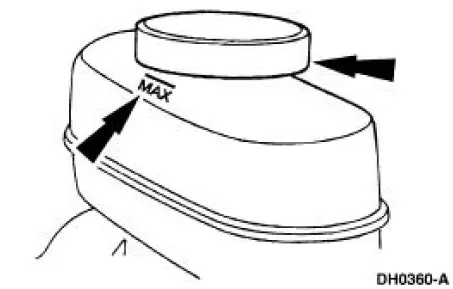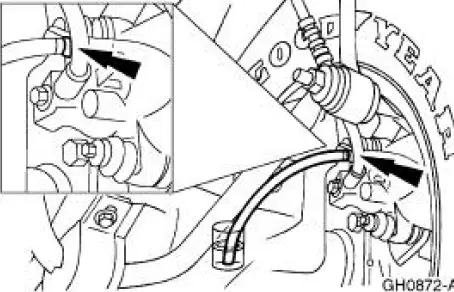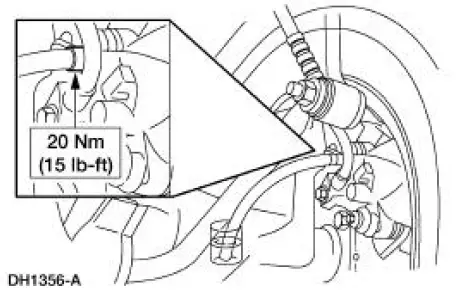Ford Mustang (1999-2004) Service Manual: Pressure
1. Clean all dirt from and remove the brake master cylinder filler cap and fill the brake master cylinder reservoir with the specified brake fluid.

2. NOTE: Master cylinder pressure bleeder adapter tools are available from various manufacturers of pressure bleeding equipment. Follow the instructions of the manufacturer when installing the adapter.
Install the bleeder adapter to the brake master cylinder reservoir, and attach the bleeder tank hose to the fitting on the adapter.
3. NOTE: Bleed the longest line first. Make sure the bleeder tank contains enough specified brake fluid to complete the bleeding operation.
Place a box end wrench on the RH rear bleeder screw. Attach a rubber drain tube to the RH rear bleeder screw, and submerge the free end of the tube in a container partially filled with clean brake fluid.

4. Open the valve on the bleeder tank.
5. Loosen the RH rear bleeder screw. Leave open until clear, bubble-free brake fluid flows, then tighten the RH rear bleeder screw and remove the rubber hose.

6. Continue bleeding the rear of the system, going in order from the LH rear bleeder screw to the RH front disc brake caliper bleeder screw ending with the LH front disc brake caliper bleeder screw.
7. Close the bleeder tank valve. Remove the tank hose from the adapter, and remove the adapter.
Hydraulic Leak Check
1. NOTE: Brake fluid is water soluble and it is possible that all evidence of fluid leakage has been washed off if the vehicle has been operated in the rain or snow.
Make sure the brake master cylinder reservoir (2K478) is full.
2. Apply the brakes several times and make sure the brake pedal (2455) feel is not spongy. If necessary, bleed the system. For additional information, refer to Bleeding-System in this section.
3. If the reservoir level is dropping, inspect the brake components, fittings and lines to locate the source of the leak.
 Manual
Manual
WARNING: Brake fluid contains polyglycol ethers and polyglycols.
Avoid contact with
eyes. Wash hands thoroughly after handling. If brake fluid contacts
eyes, flush eyes with
running water fo ...
 Runout Check - Brake Disc and Hub
Runout Check - Brake Disc and Hub
Special Tool(s)
Brake Measurement Kit
134-R0199 or equivalent
Material
Item
Specification
High Temperature Nickel Anti-
Seize Lubricant
F6AZ-9L494-AA
ESE-M12A4-
A
...
Other materials:
Inspection and Verification
WARNING: Use of any other than the approved DOT 3 brake fluid will
cause permanent
damage to brake components and will render the brakes inoperative.
WARNING: Brake fluid contains polyglycol ethers and polyglycols. Avoid contact
with
eyes. Wash hands thorou ...
Installation
All vehicles
1. NOTE: Inspect the insulators for wear or damage. Install new
insulators if necessary.
Install the upper insulator on the spring.
2. Install the lower insulator on the lower arm.
3. Install the rear spring. Make sure the pigtail on the low ...
Connecting Rod - Side Clearance
1. Measure the clearance between the connecting rod and the crankshaft.
Verify the measurement
is within specification.
Refer to the appropriate section in Group for the procedure.
If out of specification, install new components as necessary. Refer
...
